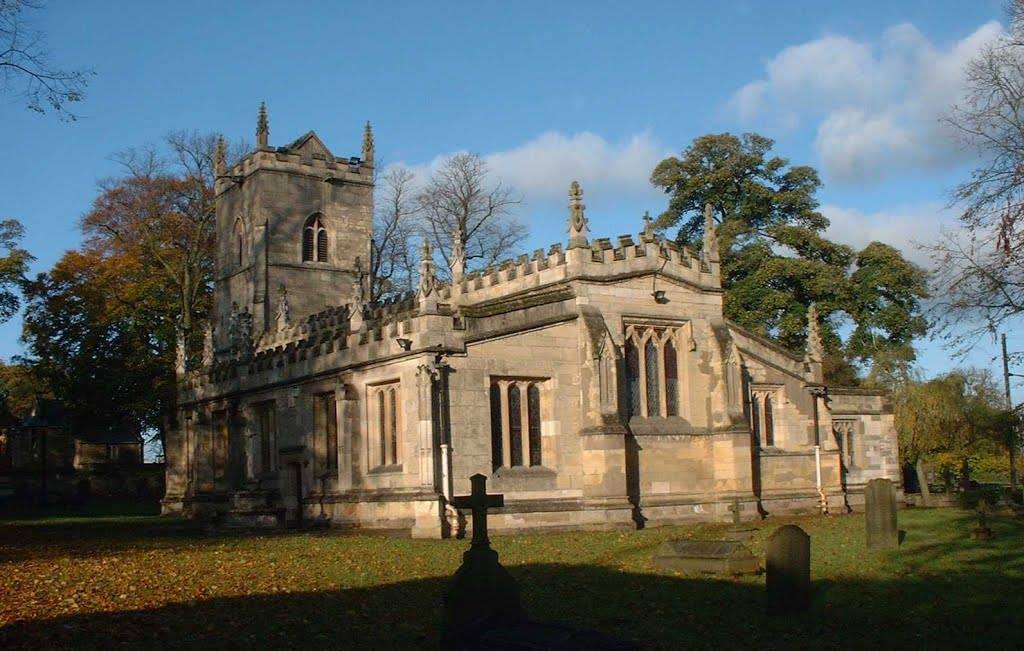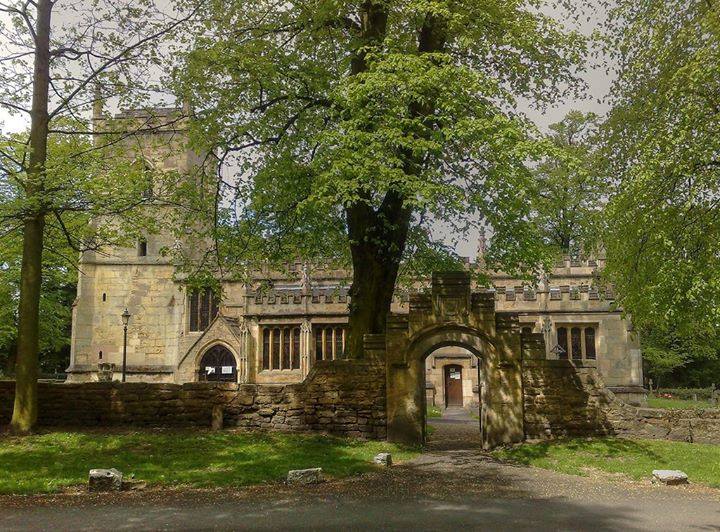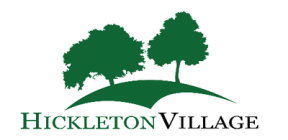There has been a church at Hickleton since, at least, Norman times as indicated by the chancel arch and font. But, the building you see today is essentially Perpendicular in style incorporating a typical South Yorkshire Magnesian limestone west tower. The church is a large building when compared with the size of the parish, possibly reflecting the creation of wealth, from wool, under the influence of the Priory of Monk Bretton over three centuries, from the thirteenth to the sixteenth, until the Priory was dissolved and the Crown disposed of its land and wealth.

Outside, the church is pinnacled, embattled and consists of a double aisle Nave and Chancel. The Nave arcades differ, on the north side two bays and on the south, one wide arch on brackets, but this aisle stops short to accommodate a south porch. The chancel chapels differ again, the south side is older and the north is Victorian along with the Vestry.
Inside, the church is lavishly furnished at the expense of the Halifax family who were also responsible for the Victorian restoration and the removal of the gallery, box pews and the alteration from a two tier -to a single tier pulpit. This used to carry the arms of the Jackson’s of Hickleton who also provided box pews, but still has some flamboyant tracery in the top half of the panels.
Finds from the complete archaeological investigation into Hickleton church give an insight into our ‘place in history.’ This can be summarized as follows:
1. Three-hundred and three animal bone fragments were recovered during the excavation, the assemblage consisting mainly of butchered and food debris from domesticated animals which include pig, horse, fallow deer, dog, hare, rabbit, with various birds fowl, duck, goose, pigeon, and rook and crow. But they are mainly from cattle and sheep.
2. The site produced 230 shards of pottery, representing 73 vessels in 16 defined groups; York ware, Shelly ware, Pimply ware, Fine sandy, Smooth textured, Rough sandy, Hallgate type, SY Gritty ware, Stamford ware, Grey reduced, Fine pink, Firsby/Rawmarsh ware, Cistercian ware, Late medieval red ware and Skipton-on-Swale jugs 13-14th century. The conclusion to the pottery report show three functional groups are identified: the pre-church pottery, almost certainly not all contemporary, but reflecting nearby occupation in the eleventh century and earlier; material used by construction workers of the church, best seen in the Hallgate-type jugs and other vessels of phase five found with worked stone chippings in the north aisle; and seemingly domestic material associated with the church. Churchwardens’ accounts frequently record regular purchase of oil and occasionally earthenware pots to keep it in, needed to light the church but more importantly to light religious lamps burning before the altar.
3. Architectural stone fragments were also recovered. Three main groups have emerged: arcade pieces, including voussoirs bearing decoration; fragments from 12th century windows; and three pieces from a late 11th century doorway. Elements of the painted decoration of acanthus leaves in relief and orange trumpet flowers have been brought together here to give a glimpse of the 12th and 13th century church interior design.
4. Before the 1983 excavations, three cross slabs were known at Hickleton. During the investigation a further seven slabs or part slabs were discovered. The first was a slab found reset in the footings of the 14th century south wall of the nave, of a round leaf design (c1250-1300) and the near pristine condition of the stone, with its reuse in the mid-14th century, points to a date not much before this time. The report which gives more details also states a strong probability that the slab commemorates an earlier member of the Haringel family. But the main, and most ornate grave cover was this one shown on the left of Robard [Robert] Haringel that dates to the early 14th century. The Haringel family, whose short stay as lords of the manor became significant, when, during the 1983 excavation of the church an elaborately carved semi-effigy grave cover, was discovered. The first documented reference in Hunter is in 1316 when Robert Haringel, Thomas Ashebury and Giles de Hickleton have shares in the manor of Hickleton.
5. Before the church excavations, specialists and visitors alike saw little, other than Victorian stained glass, to excite them. Now with the discovery through excavation and the specialist report by B Sprakes and the more detailed report by C P Graves, Hickleton has been brought to centre stage overnight. For awaiting discovery in the chancel was a deposit of grisaille glass and on investigation revealed two forms which date to the late 12th/early 13th century and late 13th century material all found within a three metre square area containing almost 200 pieces. Very little glass of this period is known in Britain, let alone a parish church, which makes the Hickleton glass a significant discovery. It also suggests a wealthy patronage or status which the church subsequently lost.
6. One part that’s missing from the report compilation is the small finds, some of which are now on display in Doncaster museum in the medieval section. The first is a pin dated 1300-1500 with no other details. A rock crystal on display c1250-1450 states that its purpose is a mystery but goes on to speculate that it may have come from a reliquary (relic box) or other piece of altar furniture. The first draft report of 1983 suggested it was a ‘crystal eye’ for viewing a tiny relic of a dead saint, but the mineral report received three years later states that it is a colourless polished stone, a carved oval cabochon made of quartz referred to as a rock crystal. A Papal Bulla, 1285-1287, recovered during the archaeological investigation from Pope Honorius IV (1285-87) may have been attached to the final authority regarding the small tithes at Hickleton. Next is a ‘lead fitting’ dated 1300-1400. The inner and outer surface carry traces of a design, maybe religious symbols or possibly merchant marks. While the conclusion of the museum is that its purpose is unknown, it could have come from any number of items used and associated with Hickleton church. For instance, it may well be from a bale or sack of wool that was being exported out of Hickleton by the monks of Monk Bretton. Some of these seals are on display at Fountains Abbey, near Ripon that are very similar in overall appearance. Displayed one item away from this piece of lead is a silver ring, dated 1100-1250, with a square bezel (cut edge) with the hoop flaring out towards the shoulders with a cross-pattern decoration applied with solder. This came from a burial of a priest in the early 13th century extension to the chancel.

Stained Glass
The windows are mostly straight-headed of different varieties, some with cusps and some without, reflecting the architectural piecemeal building of the whole church. Much of the glass is Victorian. The stained glass in the windows of the south and north chapels and east and west windows placed there in 1886 and 1887, the gift of the second Viscount Halifax. The various shields of arms represent the various families connected with the Woods of Hickleton and other families connected in some way or other with the parish of Hickleton. The two medallions in the north nave aisle, west window are thought to be of a seventeenth century date and attributed to the work of Henry Gyles of York, showing the arms of the Jackson’s of Hickleton and associated families. Small quantities of 12th and 13th century Grisaille and painted window glass were found during the 1983 excavations, which came from a Norman nave and then a chancel window in the east elevation.
Church History
Despite the church’s chequered past of growth, decay and growth, a three-hundred year association with the Priory of Monk Bretton, its many owners of the advowson and more recently its rescue from dereliction in the form of underpinning, Hickleton church should be remembered for its long association with the champion of Anglo-Catholic reunion – the second Viscount Halifax and for the three skulls he so provocatively displayed in the lych gated entrance from the village.
An outline of the building history of the church is told in a book by John A Dabell entitled ‘St. Wilfrid’s Church Hickleton: The Building Development of a Parish Church.’ Number one in the Hickleton Parish Series, published by the Hickleton Heritage Trust.
The book measures approximately 15 cm by 21 cm and contains 67 packed pages with nine chapters covering topics as follows; 1 Introduction; 2 An outline of the village; 3 Christianity in England; 4 The foundation of Hickleton church; 5 Hickleton church during the reformation; 6 Victorian restoration; 7 Twentieth century remedial work; 8 The twenty-first century; 9 Epilogue. Included are three black and white photographs, with ten line drawings of heraldry and building plans.
All profits from the sale of these publications have been donated to Hickleton’s Heritage by the author.
Copies can be obtained direct from the author at this email johndabell@freenetname.co.uk. The cost is £3.00 plus 80p postage and packing.
Incumbents
A supplement to the book on the building development has been produced to bring together as much information as possible on the ‘Known Incumbents Serving at St. Wilfrid’s Parish Church Hickleton c1150-1999’ compiled by John A Dabell. Number three in the Hickleton Parish Series, published by the Hickleton Heritage Trust. The supplement measures approximately 15 cm by 21 cm and consists of 16 pages of small font printing with an introduction followed by three sections covering the periods 1150-1535, 1559-1817 and 1817-1999 all complete with an overview of the period and notes quoted from the sources relating to each incumbent. A glossary of terms relating to clerical positions and terms within the church is included at the end.
All profits from the sale of these publications have been donated to Hickleton’s Heritage by the author.
Copies can be obtained again direct from the author at johndabell@freenetname.co.uk. The cost is £1 plus 35p postage and packing.
LATEST NEWS
- (no title) July 11, 2017
- Annual internal audit report July 11, 2017
